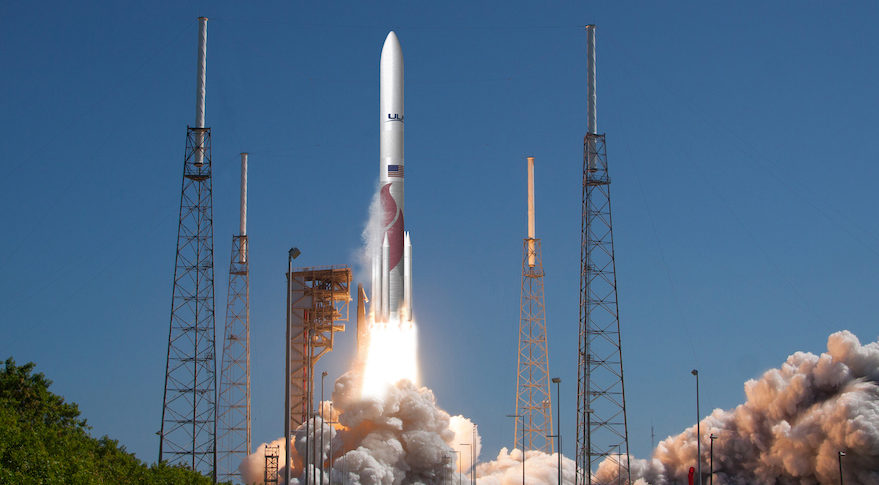
ULA Vulcan Centaur rocket illustration
IAC 2019: The Pentagon, which still hasn’t issued contracts for the next generation of launch services, is already discussing post-2027 launch requirements to confront evolving threats from Russia and China, says United Launch Alliance CEO Tony Bruno. Those new launch requirements could include the capability to reach cislunar space, very rapid relaunch rates, and bays to carry payloads even bigger than today’s heaviest, school-bus sized satellites.
Bruno said that Space Command, the Air Force and the Space Development Agency all are trying to get an early grip on requirements in the “warfighting environment” well beyond current plans under the National Security Space Launch (NSSL) Phase 2 Launch Service Procurement competition.They also are quizzing US launch providers about what technologies the private sector might be able to bring to help counter US adversaries.
“They (Space Command) have been engaged with industry on the challenges that they are facing in coping with space as warfighting domain, and asking people for ideas, for evaluations of theories, for trade studies and assessments,” Bruno said.
Likewise, he said, the Space Development Agency is engaging with industry about future national security launch needs. “It’s very important that we understand what is going to be demanded of us,” he said, “so that we invest in the right way, and we spend our R&D dollars correctly … to meet warfighter needs.”
ULA has already anticipated some of those future needs in its Vulcan Centaur heavy lifter design for the NSSL Phase 2 competition — including the capability to launch national security payloads into cislunar orbit, Bruno told Breaking D.
“We chose also to give a little bit more performance, a little bit more flexibility than was asked for, anticipating that it was going to be needed,” he said. “So, we have more mass that we can take to higher energy orbits, we have a much larger payload volume that can accommodate multiple payloads going up at the same time, and physically larger payloads.”
Readers of Breaking D will be familiar with the fact that placing space situational awareness satellites, and possibly even interceptor weapons, in cislunar orbit, is a key part of nascent plans by SDA for a new space architecture.
Bruno said at the 2019 International Astronautical Congress that he “would not be surprised” if the Air Force NSSL Phase 3 competition includes a requirement for responsive launch. With that in mind, he noted that ULA will be able to turn around a Vulcan launch in only 11 days; with the ability to launch only five days after a satellite becomes available, once its Atlas V launchpads at Cape Canaveral are fully modified to host the Vulcan. The Atlas V in August launched the Air Force’s fifth Advanced Extremely High Frequency (AEHF) communications satellite and the second GPS III satellite.
“My personal opinion is that Phase 2 represented the best understanding of what they would need in the near term to cope with space as warfighting domain,” he noted. However, as adversaries continue to work to undercut US space capabilities, “that understanding will change. So, Phase 3 is the next opportunity to update those needs and requirements, and have another competition to allow those new capabilities to be on ramped.”
The beleaguered $2.3 billion NSSL effort is slated to down-select from the four current competitors — ULA, Northrop Grumman, SpaceX and Blue Origin — to two launch providers in June 2020. (Currently, ULA and SpaceX launch the bulk of US national security payloads.) The two winners, under a 60/40 split, will be contracted for some 30 national security launches between 2022 and 2027, representing hundreds of millions — if not several billion — dollars in contract awards. Phase 3 would commence after that, opening up the possibility for other competitors to be chosen.
However, the competition has been formally protested by both SpaceX and Blue Origin and is still in court. The House version of the 2020 National Defense Authorization Act (NDAA) would change the competition in ways the Trump Administration says will delay the NSSL effort by an “unacceptable” one to two years. The House and Senate are currently in conference on the NDAA, but are unlikely to reach agreement before the Nov. 21 expiration of the current Continuing Resolution as impeachment proceedings suck all the air out of Capitol Hill.
Bruno said that the Air Force has conducted “what-if scenario” discussions with ULA about NSSL delays. He said he believes that ULA could absorb “normal” delays in the competition, “because we could plan to use the margins.” But, he stressed, “a major disruption to the acquisition will be a big problem,” saying that even a one- to two-year delay would be “really bad.”
Northrop sees F-16 IVEWS, IBCS as ‘multibillion dollar’ international sales drivers
In addition, CEO Kathy Warden says the company sees a chance to sell up to five Triton UAVs to the NATO alliance.


























